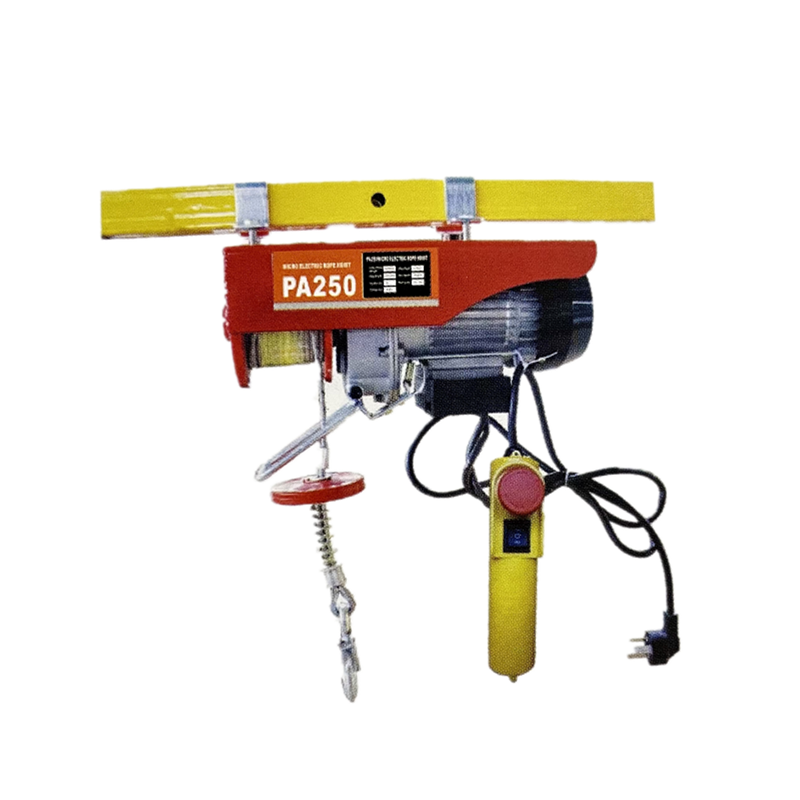


If you’re browsing for a pa mini electric hoist, chances are you need something compact, honest-to-goodness reliable, and quick to install. These units come out of places like Donglv Industrial Zone, Donglu Township, Qingyuan District, Baoding City, Hebei Province—where hoisting isn’t just a product, it’s a habit formed over decades. Juli Hoisting’s line is a good example: straightforward design, single-phase 220V, and a knack for vertical lifting between floors. Actually, many customers say the biggest surprise is how “plug-and-lift” the setup feels.

The small-hoist market is shifting toward smarter safety (dual braking, thermal protection) and lighter frames. In fact, the demand is rising in last-mile logistics and small workshops. You see more pa mini electric hoist units hung on column or wall jib cranes, tucked into mezzanines, or serving apartment retrofits. To be honest, not glamorous—just quietly indispensable.
| Item | Spec (≈, real-world use may vary) |
|---|---|
| Rated load | 100–500 kg single-line; up to 200–1000 kg double-line |
| Lifting speed | ≈10 m/min (single); ≈5 m/min (double) |
| Lift height | ≈12 m (single); ≈6 m (double) |
| Motor power / duty | ≈500–1200 W; S3 ~20% (10 min) |
| Voltage | Single-phase 220V, 50Hz |
| Protection | Thermal overload, upper limit stop, IP54–IP55 motor (typ.) |
| Rope / brake | Steel wire rope ≈4–6 mm; electromagnetic brake |

Advantages? Compact body, quick install, single-phase power, and—this is underrated—predictable maintenance. A well-kept pa mini electric hoist easily reaches multi‑year service life under S3 duty.
Materials: cold-rolled housings, copper-wound motors, alloy steel hooks, galvanized wire rope. Methods: CNC-formed frames, powder coating, automated winding and balancing. Typical testing: 125% static load and ≈110% dynamic as per EN 14492‑2; insulation check; no‑load heat run; functional brake test; limit-switch verification. Service life varies, but users report thousands of cycles when operated within duty limits and kept lubricated.

| Factor | Juli Hoisting | Vendor A | Vendor B |
|---|---|---|---|
| Motor winding | Copper (stated) | Mixed | Copper |
| Brake | Electromagnetic + reducer | Electromagnetic | Electromagnetic |
| Certs | CE basis, RoHS (as applicable) | CE claim | CE + in-house test |
| Duty data | S3 details disclosed | Basic brochure | Partial disclosure |
| Lead time | Fast for standard SKUs | Variable | Moderate |
Options include custom lift height, pendant length, trolley kits, and wall/column jib pairings. One small logistics team in Tianjin (five-story walk-up) retrofitted a pa mini electric hoist with a wall jib; their hauling time per delivery dropped by roughly 40%—not fancy math, just a stopwatch and fewer sore backs. Another factory line paired two units for staged feeding; uptime improved because operators could rotate tasks while one unit cooled between S3 cycles.

Look for conformity with the EU Machinery Directive, EN 14492‑2 (power-driven hoists), and ASME B30.16 where relevant. Typical factory tests: 125% static load, 110% dynamic, insulation resistance ≥1 MΩ at 500 V DC, brake stopping under rated load within spec. Always read the manual, keep the rope spooled properly, and don’t exceed S3 duty—it matters more than people think.



